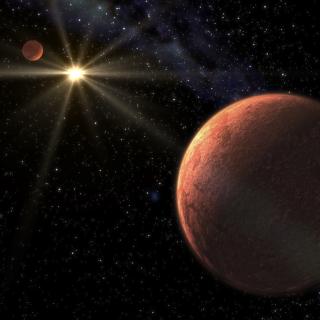Bibcode
Dreizler, S.; Luque, R.; Ribas, I.; Koseleva, V.; Ruh, H. L.; Nagel, E.; Pozuelos, F. J.; Zechmeister, M.; Reiners, A.; Caballero, J. A.; Amado, P. J.; Béjar, V. J. S.; Bean, J. L.; Brady, M.; Cifuentes, C.; Gillon, M.; Hatzes, A. P.; Henning, Th.; Kasper, D.; Montes, D.; Morales, J. C.; Murray, C. A.; Pallé, E.; Quirrenbach, A.; Seifahrt, A.; Schweitzer, A.; Stürmer, J.; Stefánsson, G.; Linares, J. I. Vico
Referencia bibliográfica
Astronomy and Astrophysics
Fecha de publicación:
4
2024
Revista
Número de citas
14
Número de citas referidas
11
Descripción
The two known planets in the planetary system of Teegarden's Star are among the most Earth-like exoplanets currently known. Revisiting this nearby planetary system with two planets in the habitable zone aims at a more complete census of planets around very low-mass stars. A significant number of new radial velocity measurements from CARMENES, ESPRESSO, MAROON-X, and HPF, as well as photometry from TESS motivated a deeper search for additional planets. We confirm and refine the orbital parameters of the two know planets Teegarden's Star b and c. We also report the detection of a third planet d with an orbital period of 26.13 ± 0.04 days and a minimum mass of 0.82 ± 0.17 M⊕. A signal at 96 days is attributed to the stellar rotation period. The interpretation of a signal at 172 days remains open. The TESS data exclude transiting short-period planets down to about half an Earth radius. We compare the planetary system architecture of very low-mass stars. In the currently known configuration, the planetary system of Teegarden's star is dynamically quite different from that of TRAPPIST-1, which is more compact, but dynamically similar to others such as GJ 1002.
Full Table A.1 is available at the CDS via anonymous ftp to cdsarc.cds.unistra.fr (ftp://130.79.128.5) or via https://cdsarc.cds.unistra.fr/viz-bin/cat/J/A+A/684/A117
Based on observations collected at the European Southern Observatory under ESO programme(s) 0103.C-0152(A).
Proyectos relacionados

Estrellas de Baja Masa, Enanas Marrones y Planetas
Se investigan los procesos que conducen a la formación de estrellas de baja masa, enanas marrones y exoplanetas y caracterizar las propiedades físicas de estos astros en varias etapas evolutivas. Las estrellas de muy baja masa y las enanas marrones son probablemente los objetos más numerosos de nuestra Galaxia, pero no por ello están
Rafael
Rebolo López

Exoplanetas y Astrobiología
La búsqueda de vida en el Universo se ha visto impulsada por los recientes descubrimientos de planetas alrededor de otras estrellas (los llamados exoplanetas), convirtiéndose en uno de los campos más activos dentro de la Astrofísica moderna. En los últimos años los descubrimientos cada vez más numerosos de nuevos exoplanetas y los últimos avances
Enric
Pallé Bago